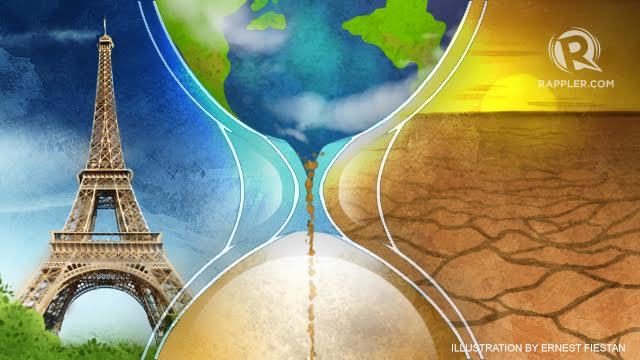SUMMARY
This is AI generated summarization, which may have errors. For context, always refer to the full article.
 Like reading the ancient Greek tragedy of Homer, we are at the pages of the Iliad where we can see what hell ahead shall befall Troy. We are now in that exact moment, seeing in the horizon the fires that will burn for 10 years. However, we are not looking in the horizon of the ill-fated Trojans, but rather, we are looking at the future of humanity, nature, and the planet.
Like reading the ancient Greek tragedy of Homer, we are at the pages of the Iliad where we can see what hell ahead shall befall Troy. We are now in that exact moment, seeing in the horizon the fires that will burn for 10 years. However, we are not looking in the horizon of the ill-fated Trojans, but rather, we are looking at the future of humanity, nature, and the planet.
There are only 5 negotiating days left before the 21st Conference of the Parties (COP21) to the United Nations Framework Convention on Climate Change (UNFCCC). From October 19 to 23, the UNFCCC is supposed to hammer out the modalities of the Paris deal. And all the indications, for me, are pointing out that any deal coming out of Paris will be a bad one.
In the 85 negotiating days since COP17 in 2011 (in Durban, South Africa), when governments agreed to draft a new climate agreement until 2030, there has been little forward movement. In spite of all the carbon-generating flights associated with flying 193 sets of negotiators around the world multiple times, what we have seen in the last 4 years is the death or displacement of thousands of people impacted by destructively intense typhoons, hurricanes, floods, and droughts.
In the Philippines alone, the strongest typhoon to ever make landfall, Typhoon Yolanda (Haiyan), killed 6,000 and left thousands more homeless and without livelihoods.
Paris deal

A document known as the “Co-Chairs Tool” – from the co-chairs of the Ad Hoc Working Group on the Durban Platform for Enhanced Action (ADP), and published at the last intersessional in Bonn in September – lays out a possible scenario for a Paris deal.
It outlines issues for a potential Paris agreement, issues that will be listed in a decision, and other issues that have not yet agreed to be either in the agreement or the decision.
The Chair’s Tool also makes the specific elements of a Paris deal fairly clear: emission cuts will be voluntary, flexibility mechanisms will be continued, more market mechanisms will be proposed, and accounting loopholes and techno-fixes will abound.
A trick term “net zero emissions” will also allow countries to offset emissions through dubious biofuels and biomass projects likely to drive landgrabbing and hunger without permanently reducing emissions.
This week, the co-chairs of the ADP, Ahmed Djoghlaf of Algeria and Daniel Reifsnyder of the United States, also produced a “non-paper note by the Co-Chairs” on October 5, in time for the coming inter-sessional in Bonn. This non-paper details a draft agreement and a draft decision for Paris. The Chairs have also issued a draft decision on the pre-2020 ambition known as “Workstream.”
All these documents are still under negotiation however. There is certainly an element of Greek tragedy in the fact that one of the co-chairs is from the US, one of the biggest emitters of greenhouse gases who never even ratified the last climate protocol.
Why it will fail

We also know that Paris is going to be a deal that burns the planet because, at the time of writing, 119 submissions of Intended Nationally Determined Contributions (INDCs) – voluntary reduction pledges – had been made, including by all major emitters.
It has been calculated that these INDCs would still mean a planetary warming of 3oC above pre-industrial levels, overshooting an international commitment by one degree.
A recent study by Stern and others also shows that the reduction pledges from the US, European Union, and China – who together account for 45% of global emissions – will miss by almost double the 2030 target of 35 gigatons of CO2e emissions.
This 2oC target was internationally agreed on in 2007, after the UN Intergovernmental Panel on Climate Change (IPCC) released its 4th assessment report (7), explaining that emissions had to be kept to below 2oC by 2020. But it is now 2015, and the IPCC’s 5th report has reiterated the peril we face, and the fact that even if we stopped all emissions now, we will still feel the impacts for centuries, including potential abrupt and possibly irreversible changes.
The longer the delay in reducing emissions, the higher the danger that the climate’s feedback mechanism will go beyond the 2oC “safe” limit.
This is the heart of the problem with the Paris deal. Countries’ voluntary emission targets, which they might not even implement, are not up for negotiation at all. They could also use market mechanisms to buy or cheat their way out of reductions at home. Yet emissions need to be cut deeply, at source, without loopholes or market mechanisms now, not in 10 years’ time.
We can’t wait to try again in 2030 – it will be too late.
Why is this happening? Well, the whole process being captured by corporations, especially by the fossil fuel and extractives industry – the main source of emissions. For example, in the entire 88 pages of the Co-Chair’s Tool, “fossil fuel” is only mentioned once and then only to encourage governments to reduce or eliminate incentives for fossil fuel subsidies.
A statement from civil society organizations in the Climate Space reiterates the demand from social movements – that 80% of fossil fuel reserves must be left underground in order to stay below the 2oC limit. But how can this demand possibly be met if the sponsors of COP21 are from fossil fuel and large carbon-emitting corporations, such as EDF, Engie, Air France, Renault-Nissan and BNP Paribas? – Rappler.com
Mary Louise Malig, is a researcher and policy analyst and has written on the issues of trade particularly the World Trade Organization (WTO), and on issues of climate change, food and agriculture. Malig is Campaigns Coordinator of the Global Forest Coalition.
Add a comment
How does this make you feel?
There are no comments yet. Add your comment to start the conversation.